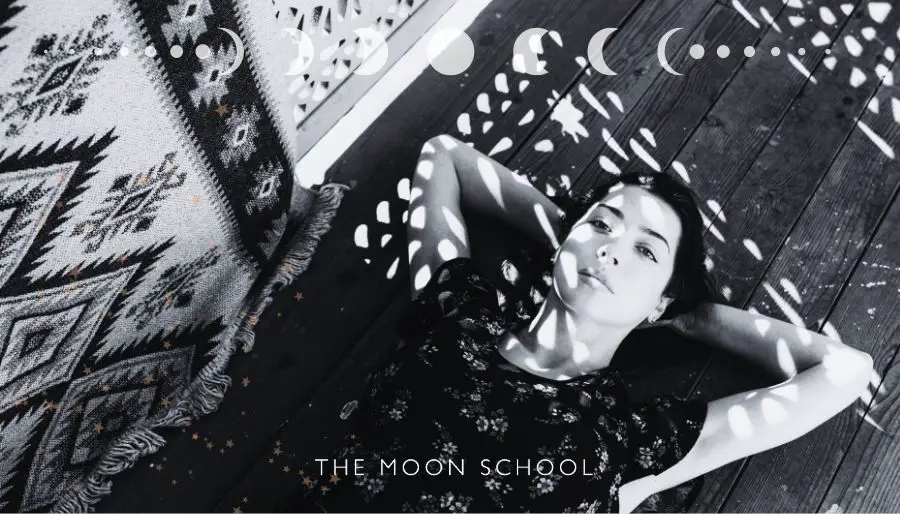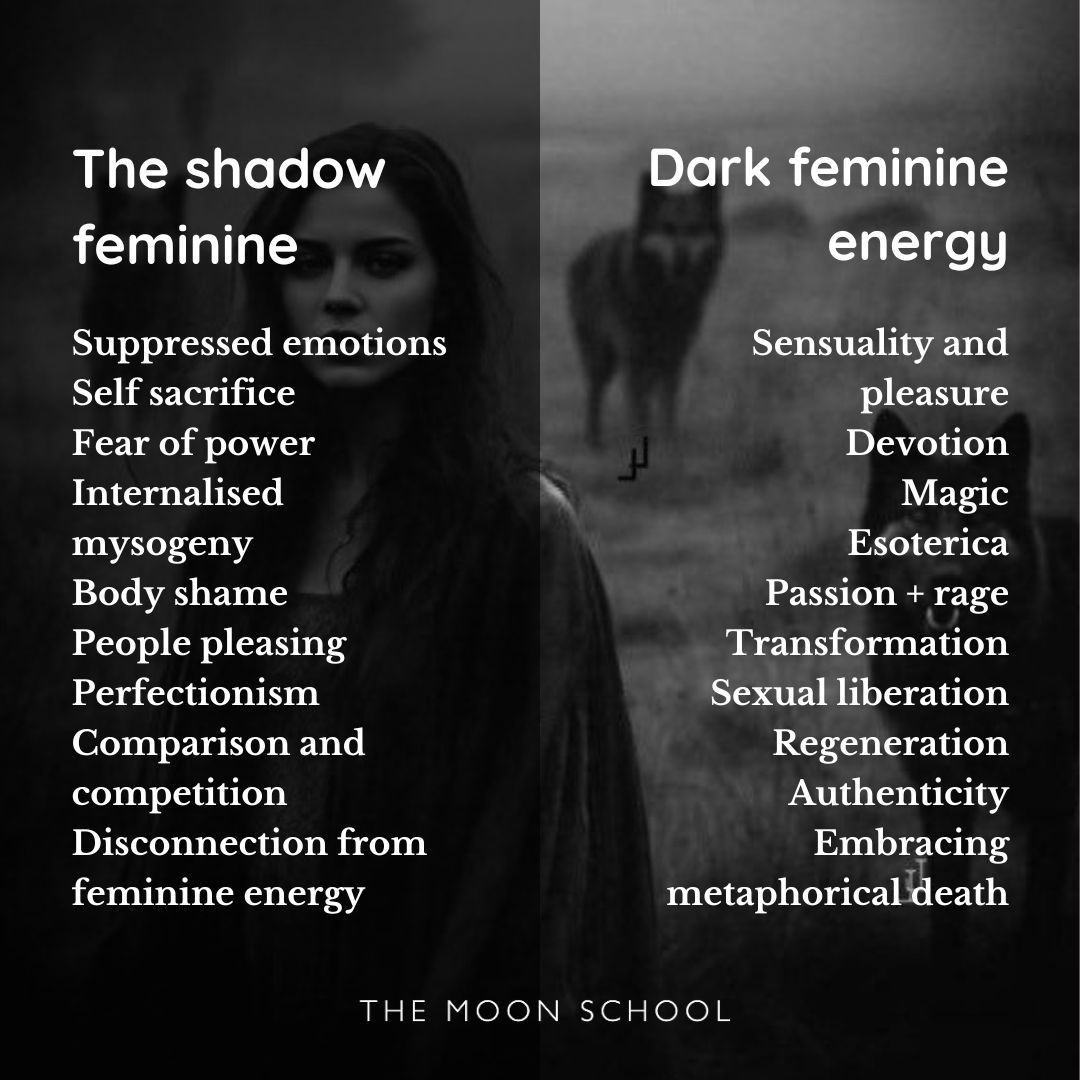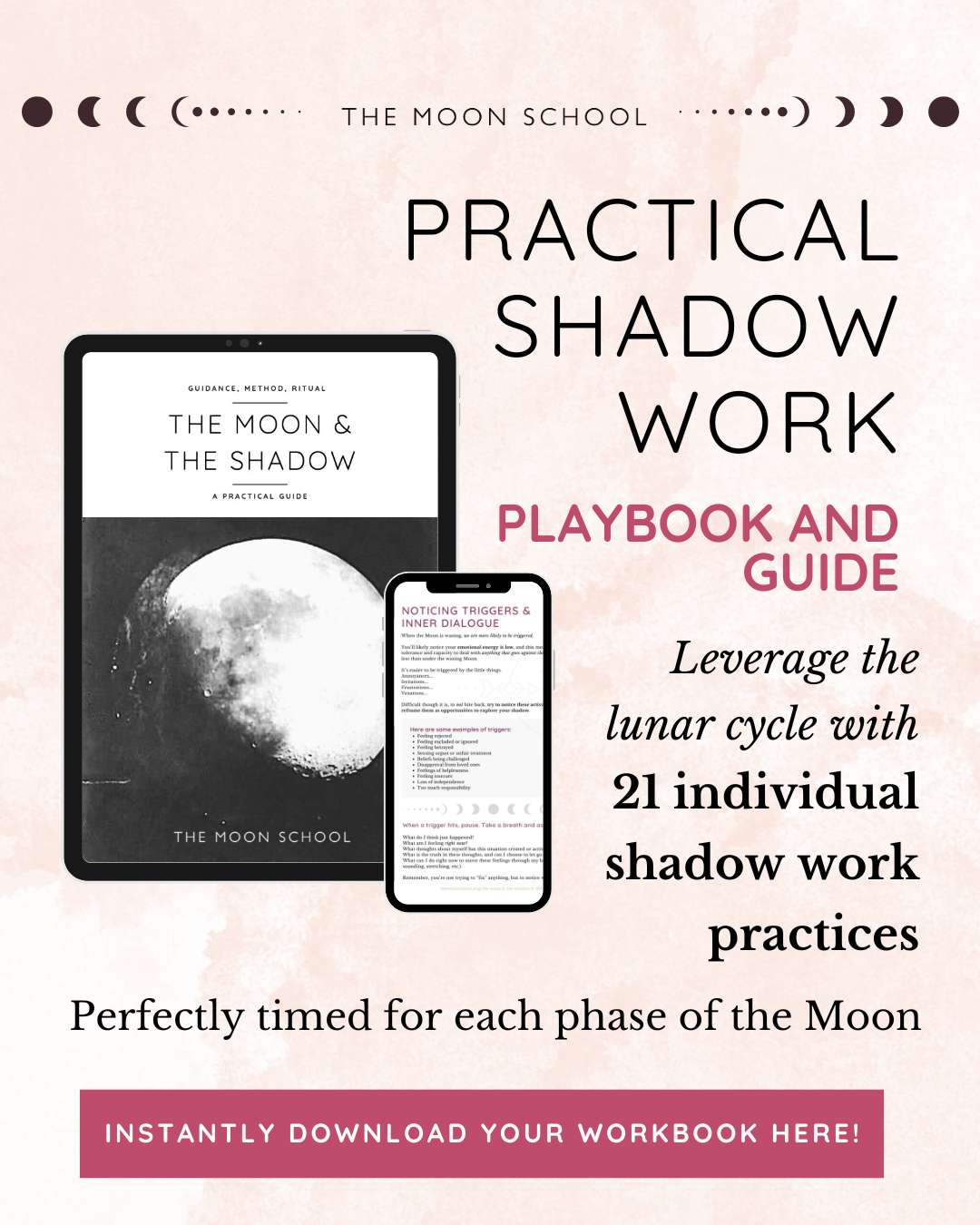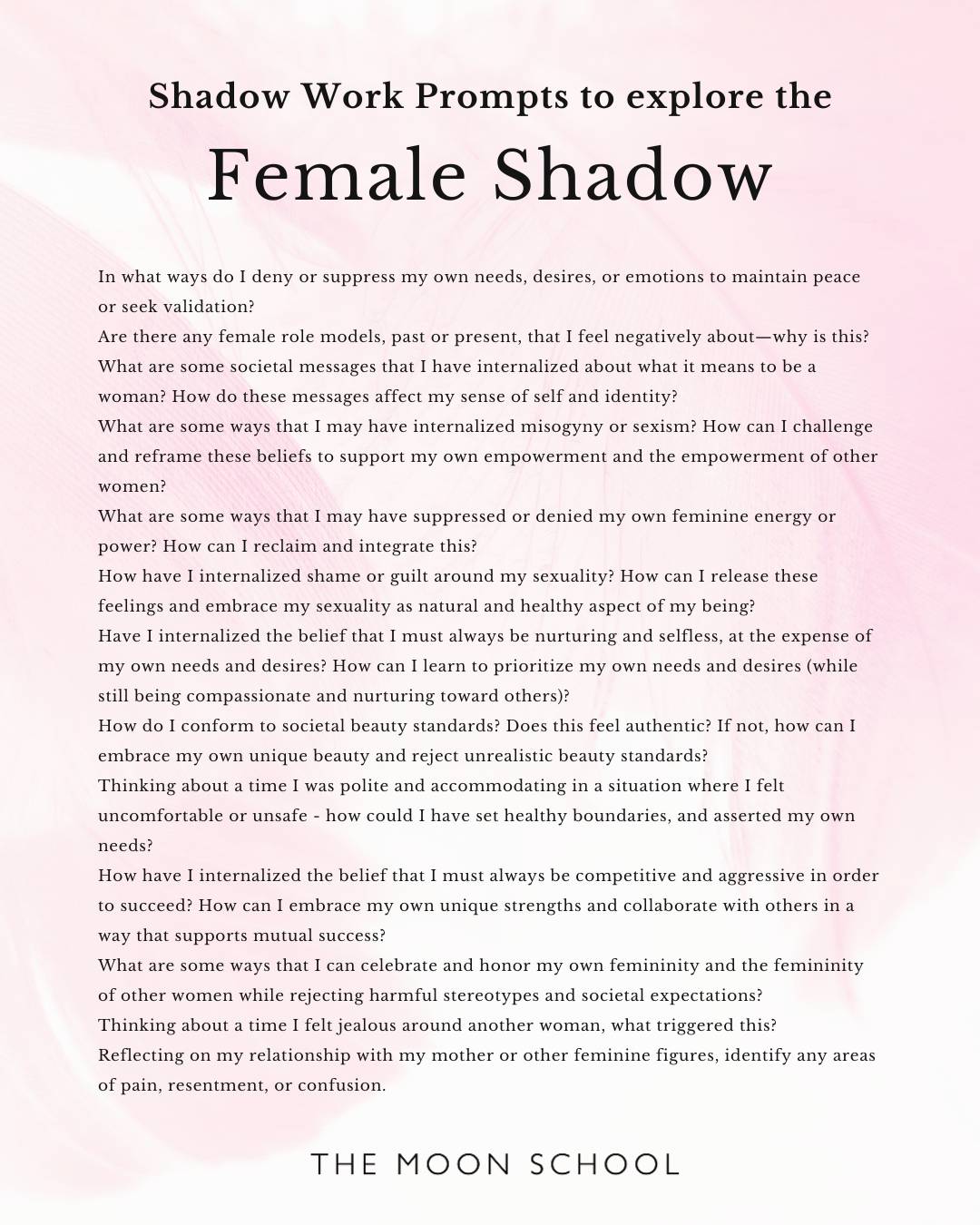I’ve noticed a trend over the past few years. There’s a lot of interest in dark feminine energy, and the darker aspects of feminine power.
BUT the dark feminine is being very easily confused with the feminine shadow, and this confusion is dangerous and misleading.
The shadow side of the feminine is not the same as the dark feminine. And it’s important this misunderstanding is straightened out. So let’s begin…
What is the feminine shadow?
At its simplest, the concept of the feminine shadow (or shadow feminine) encompasses the suppressed or neglected aspects of the feminine that are deemed unacceptable or undesirable by society.
The feminine shadow represents the unconscious aspects of the feminine psyche that have been repressed, denied, or disowned. It may include traits such as strength and assertiveness, certain emotions and intuitive abilities, or even choosing to look a certain way that goes against perceived “femininity”.
The feminine shadow also encompasses cultural and ancestral wounds passed down through generations, so it isn’t just a reflection of individual experiences.
Zoom out, and you can see how the feminine shadow pervades our cultural and societal expectations of “femininity”. And once you start really looking, you’ll see how the feminine shadow casts whole swathes of distortion, impacting how we all perceive the women in our lives.
What caused the feminine shadow to form?
Most individual shadow aspects originate in childhood, when certain aspects of our personality are deemed unacceptable, or a threat to our sense of belonging and safety. This is often due to family, schooling, certain circumstances or events.
But the feminine shadow has its roots much further back than our individual upbringings (though there’s likely still an impact).
The origins of the feminine shadow can be traced back through human history to the transition from ancient matriarchal civilizations to patriarchal dominance.
As patriarchal powers took control, they systematically dismantled the reverence and deep connection humans had with Mother Earth, the cycles of the Moon Mother, our bodies, and the intuitive wisdom of divine feminine energy that had been the foundations of life until then.
This shift severed the deep connection between humanity and the natural world, relegating the feminine to a position of inferiority and suppression.
Also read: What is Authentic Feminine Energy?
Over time (and we’re talking millennia) the values of domination, control, and exploitation replaced the sacred reverence for life and the interconnectedness of all beings.
As a result, aspects of the sacred feminine such as intuition, emotionality, and relational wisdom were marginalized. So were many dark feminine traits, such as strength, sexuality, cycles of birth and death, magic and rage.
The feminine shadow represents the suppressed aspects of the feminine that patriarchal systems have repressed, and the subsequent distortion of those aspects.
What are some feminine shadow aspects and traits?
Before we look at specific shadow aspects of the feminine, I need to tell you how important it is not to jump to judgment. Think about it – we’ve been conditioned to believe many of these traits are bad, negative, harmful, toxic, ugly, and “unfeminine”. And TBH, yes, in their distorted forms some of the behaviours that come out of them aren’t exactly rooted in love.
But that’s why doing the shadow work around these aspects and traits is so important – so that the collective and personal power and truth they contain can be freed.
A list of traits of the feminine shadow self
Suppressed emotions: Cultural conditioning has led many women to suppress their emotions to the point where we don’t know how to feel them. These include emotions like anger, sadness, and jealousy. It’s thought this may even contribute to the high rates of autoimune disease in women.
Self-sacrifice: From a young age, women tend socialised to prioritize the needs of others over their own. This can leads to a tendency to neglect self-care and personal boundaries, as well as create lead to manipulative tendencies when women can’t get their needs met directly.
Fear of power: It’s common for women to genuinely fear embracing their own power and assertiveness, due to societal expectations or past (and ancestral) experiences of oppression. Often this is entirely unconscious. It will often manifest as the inability to speak your truth.
Internalized misogyny: Cultural norms and stereotypes about femininity are SO deeply rooted in out societies. It’s the water we swim in. Most of us have internalized negative beliefs about ourselves and other women, perpetuating self-doubt and low self-worth in ourselves and others.
Body shame: A lot of women experience shame or dissatisfaction with their bodies due to societal pressure to conform to unrealistic beauty standards.
People-pleasing: The desire to be liked or accepted by others AT ALL COSTS can lead women to prioritize external validation at the expense of their own authenticity and autonomy. This can result in codependency in relationships, and the abandonment of personal needs.
Difficulty setting boundaries: A lot of women struggle to assert their boundaries and say no, fearing conflict or rejection. (And it’s a REAL fear – often rooted in ancestral trauma).
Perfectionism: The overriding pressure to play multiple roles in life (mother, caregiver, career woman, and homemaker for eg) can contribute to a perfectionistic mindset that leads to feelings of inadequacy and burnout for many.
Comparison and competition: The sisterhood wound. A tool of patriarchy has been to pit us against each other, so many women compare and compete. This continues to be fueled by societal messages that promote rivalry and scarcity rather than collaboration and sisterhood.
Disconnection from feminine energy and wisdom: The devaluation of feminine qualities such as intuition, emotional intelligence, and flow has led so many women to disconnect from their innate feminine energy, wisdom and intuition, seeking validation and guidance externally rather than trusting their own inner knowing.
I’d be bold enough to say that most of these shadow traits are trauma-related, and represent deep levels of abandonment that come from the historic suppression of the feminine principle.
They are defence mechanisms, created to enable us to survive in a system that was not designed for women. (AND this patriarchal system is terrible for most men too – their relationship to the feminine has also suffered greatly over the past few thousand years).
The feminine shadow vs dark feminine energy
The feminine shadow and dark feminine energy are distinct yet because they’re interconnected aspects of the feminine, they often get confused.
We know by now that the feminine shadow encompasses the neglected and suppressed aspects of the feminine, deemed unacceptable by societal norms and expectations.
On the other hand, dark feminine energy refers to the potent and primal forces of the feminine that exist beyond societal conditioning.
Dark feminine energy embodies the raw, unbridled power of feminine creativity, sexuality, magic and destruction. Yet these are exactly the qualites that have always been the biggest threat to dominator paradigms. Becusse of this threat, it’s dark feminine power that has been denied and suppressed the most over many, many centuries.
Very often, dark feminine energy is locked within the feminine shadow. But whilst it’s there (as it has been for centuries) it gets distorted into something else. So when it escapes, it takes the form of:
- Anger
- Frustration
- Manipulation
- People pleasing
- Drama queen tendencies
- Codependency
- … and many other behaviours that are the manifestation of the female shadow self.
While the feminine shadow is rooted in personal and collective wounds, dark feminine energy taps into the primal and transformative aspects of the feminine, offering liberation and empowerment when embraced consciously.
How to work with the feminine shadow
When doing any shadow work, it’s vitally important to practice self-compassion, as you approach this deeper level of yourself. Facing your own shadow can be triggering, so ensure you’re well-resourced and have some nervous system awareness so you can regulate when needed.
Remember – the shadow contains qualities, traits, and characteristics that have been suppressed over many generations because we’ve all been conditioned to reject them. When you go exploring the hidden inner world of your shadow, you won’t necessarily like what you find.
Approach your shadow with curiosity, an open mind and an open heart, and Be prepared for big feelings to rise, and tough emotions to swell as your identity is challenged.
Here are some ways to explore the feminine shadow. Don’t try everything at once. Focus on one or two techniques that call to you, and go from there…
1. Self-reflection and awareness
Begin by exploring and acknowledging the aspects of your femininity that you have repressed or denied. Introspective practices such as journaling are a great place to start uncovering unconscious patterns and beliefs.
Use prompts that encourage self-exploration and address the wounded feminine.
2. Compassionate inquiry
Approach your feminine shadow with compassion and curiosity rather than judgment. Cultivate a non-judgmental attitude towards yourself, recognizing that your shadow aspects are a natural and integral part of your being.
3. Archetypal exploration
Explore archetypes of the dark feminine, such as the witch, the dark mother, or the wild woman. Study these archetypes through literature, mythology, or psychology to gain a deeper understanding of the traits they contain, that you may be unconsciously rejecting.
This will help you to explore the layers of your feminine shadow, and any feelings of resistance and denial.
4. Somatic practices
Engage in body-centered practices such as authentic movement, or somatic inquiry. These will help you connect with and release stored emotions and trauma held in your own body.
Movement and breathwork can help to unlock stagnant energy and facilitate the integration of your feminine shadow. And remember, these wounds may live in your body but they are collective, so it’s vital to properly process any feelings of shame that may arise.
5. Ritual and ceremony
Create rituals or ceremonies to explode, honour and embrace your feminine shadow. Light candles, set intentions, and work with symbolic imagery to discover the depths of your feminine shadow side.
You can use ritual to work with your higher self or any allies, ancestors or Spirit guides to help you through this process healing and transformation.
The reason ritual is such a powerful tool for working with the shadow self is that it touches us on the subconscious levels of our being.
Rituals help us tap into the deeper, unseen realms, tapping into archetypal forms and bypassing the human conditioning that causes so much pain.
Exploring dark feminine energy
As you explore gain a better understanding of the hidden aspects of your shadow, certain dark feminine traits will likely emerge over time.
This means exploring the dark feminine must be an integral component of your shadow work practice. Remember – the dark feminine isn’t your shadow! But when you do the work to heal and integrate your shadow aspects, you’ll likely discover your innate dark feminine energy strengthening and increasing in power.
This may look like previously suppressed anger transmuting into the ability to hold your ground, assert your needs and set strong boundaries.
Or it maybe that the emotional turmoil you used to feel, over how to handle a tricky relationship dynamic becomes clarity and inner strength to say “no”.
Over time, you will learn to embrace your shadow aspects as vital pieces of your feminine power. But be warned: As you dive deeper into your shadow work and reclaim even more dark feminine energy, you will ruffle feathers.
Many of the traits of the dark feminine are in direct contrast to traditional feminine ideals offered to us by patriarchy – assertiveness may be perceived as aggression and independence as non-conformity, for example.
As the “love and light” falls away, and you embrace the depths of authenticity, you maybe perceived as a threat to the system.
Understand that this perception often stems from the same deeply ingrained conditioning and ancestral wounds passed down through generations, alongside the feminine shadow. As you reclaim your voice, agency, and sovereignty, your very existence challenges the existing power structures that have long upheld the dominator paradigm!
This is both a wonderful thing (hurray for activism!) and a difficult thing, because it can be tempting to self-doubt, self-sabotage and abandon the personal growth journey.
Don’t!
Uncovering and reclaiming the hidden power of the shadow feminine is some of the most important work we can do in today’s world.
Keep walking the path towards a deeper connection with your true self.














